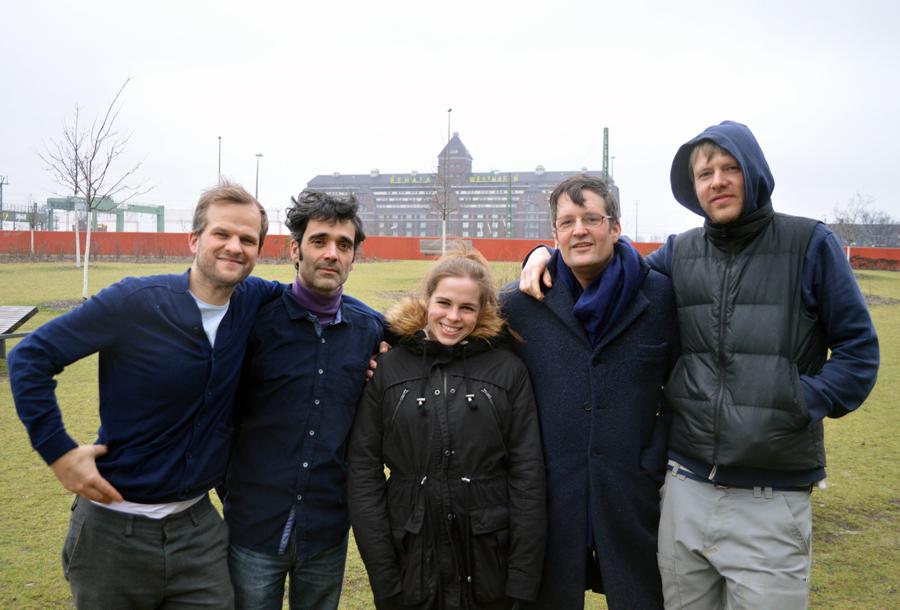Have You Met... Zentrum für Kunst und Urbanistik
Have You Met... Zentrum für Kunst und Urbanistik

In one of Berlin’s former railway depots located in Moabit is a landmark building with an overall footprint of 2000 square meters that houses Zentrum für Kunst und Urbanistik, or ZK/U for short. The ZK/U is set to become a lively hub for the transport of ideas and ideals in the postindustrial era, analogous to the nineteenth-century transport of goods by rail.
The ZK/U was opened in August 2012 by Matthias Einhoff, Philip Horst and Harry Sachs, directors of the artist collective and non-profit organization KUNSTrePUBLIK, that was formed six years ago. The ZK/U has become an innovative venue for artistic and research residencies for art production at the interface of urban research.
Today I spoke with Philip Horst, co-founder and co-director of ZK/U, to learn more about the unique collaborations that ZK/U is organizing and its upcoming program.
How did you get involved in founding Zentrum für Kunst and Urbanistik?
Philip: I have an artistic background, like all three of us, we are all visual artists. We have worked together since 2006 when we founded KUNSTrePUBLIK. At that time we started Skulpturenpark Berlin_Zentrum (together with Markus Lohmann and Daniel Seiple) in between Spittelmarkt and Moritzplatz. In summer 2012, we opened ZK/U.
What is the curatorial strategy in ZK/U?
Philip: As the name suggests, it is a center for art and urbanistics. It developed from our work in Skulpturenpark Berlin_Zentrum and it continues with our own artistic practice where we work with the city and shape situations in the city, rather than doing studio work. We are interested in community, society, and the urban structures which reflect this. Furthermore we are interested in exchange and collaboration with academics, that is why we called it Center for Art and Urbanistics.

Photo courtesy of KUNSTrePUBLIK / Samuel Kalika
What topics do you mostly deal with?
Philip: Society and communities and their images, we have an interest in bottom up processes and different models of developing and sustaining independend spaces in the city.
How are the residencies organized here?
Philip: We have different methods to organize and invite the artists and researchers coming to ZK/U. One way is collaborating with partners who provide grants to artists and researchers, which we choose together. Most residence follow our open call; artists and researchers can apply and organise their funding for themselves – the rent of the space and their budget. They are chosen by our team and the institutions they are involved with. With using these two methods, there are different kinds of boards deciding who will be coming here. Additionally, from this year on we can invite an artist directly through the donation of a grant. We are working on more opportunities like this for the future.
Our frequent program is the communal dinner every Thursday. Three artists present their work. This is kind of very informal, but it is a steady meeting for everyone, the team and the residency. Once a month we have OPENHAUS, open studios or an exhibition where the larger public is invited.
The outcome of the residencies varies, often it is in the process and fellows return to continue their piece. I really like that there are different generations coming together. There are young people who are 25 years and older people who are over sixty years old, or artists coming with their kids. There is always a variety of generations, which keeps the place interesting. It is not only one young hipster style artist, but rather many people with various experiences, backgrounds and approaches.

Photo courtesy of KUNSTrePUBLIK / Samuel Kalika
What does „continuous formation“ mean in the context of this space?
Philip: Everything here is a very organic process. Before we founded ZK/U, we had never managed a residency program or renovated buildings of this scale. Every time we do something, we learn and develop. For now we have set three very basic program frameworks. So far we have few partners to pay for the residencies, enabling artists to come for free. Others have to fund themselves. Once the number of paying partners becomes bigger, we can curate more specific programs and invite artists and researchers directly.
What distinguishes ZK/U from other art spaces in Berlin?
Philip: The place with the surrounding park and the great view on the container terminal at Westhafen is very unique. Also, the long-term perspective is maybe something different from non-institutionalised spaces in town. We have a forty year lease on the ground, so we have a long-term goal to work at the site as a platform for the arts. Also, we have some kind of independence, not financially, but in the terms of stability in the changing landscape of Berlin where project spaces continuously get lost for other long-term developments. From the curatorial statement, it is an artist run space and it is an open space for people to work and develop their ideas. We do not have a very fixed program, so we are open for suggestions and experiments or different formats. Also, we do not have to prescribe or predefine our aims like other institutions have to, so things can develop within short amounts of time. It is something like a large project space with living and working conditions.
What are your upcoming projects and plans for the future?
Philip: A lot will be shaped by the residence who are here at the time. Additonally we will be involved in larger and smaller collaborations this year.
We will have the Speisekino format again this summer: each Friday a guestfilmcurator will show a cinema program accompanied by a menu from a guest-cook or a cook team.